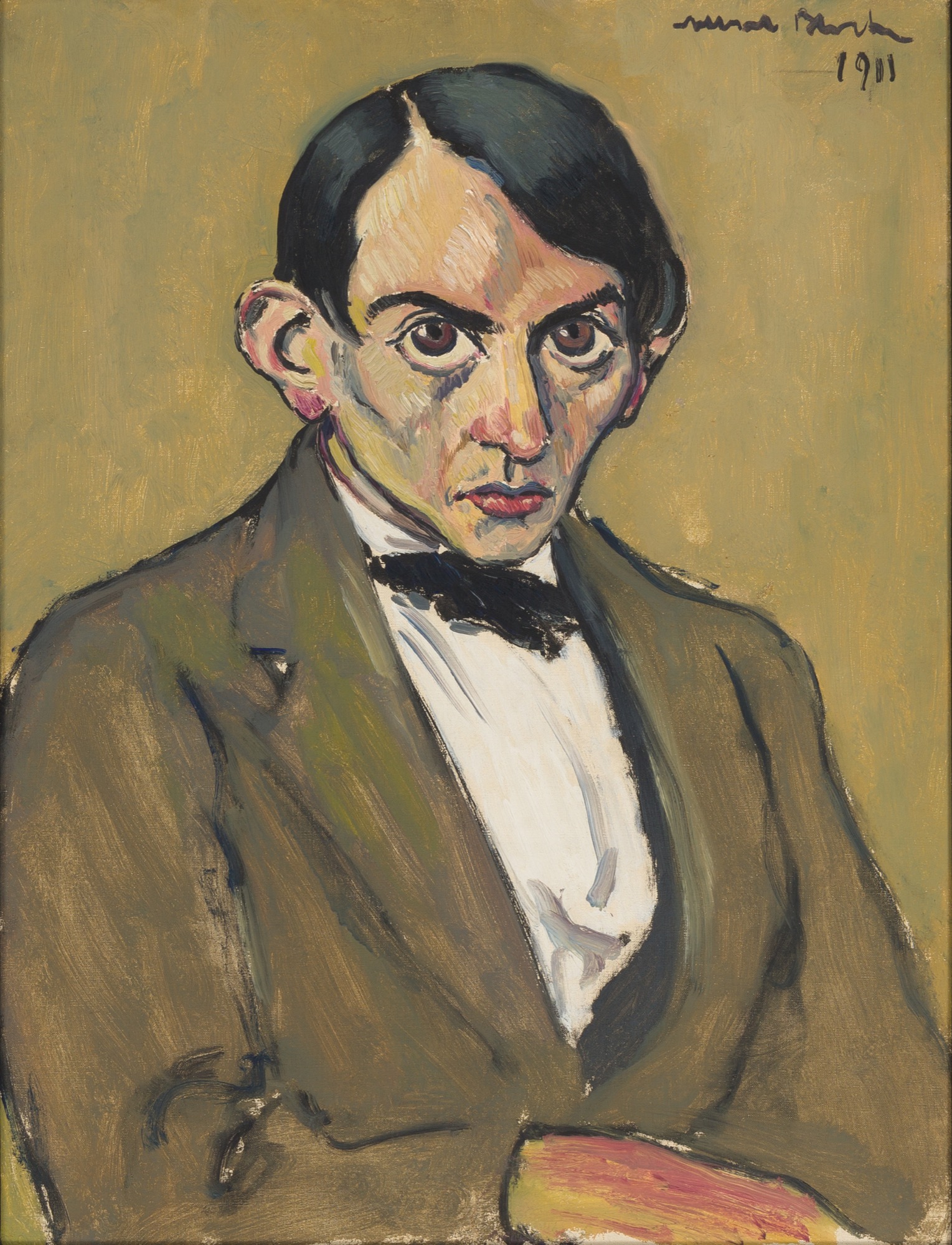Albert Bloch
Albert Bloch was an important early Modernist, and the only American associated with the Blue Rider group (Der Blaue Reiter) of progressive German and Russian artists based in Munich. Born in St. Louis, Missouri in 1882, Bloch cut his high school education short to pursue his interest in art. He briefly attended the St. Louis School of Fine Arts, now part of Washington University, leaving early to pursue a self-taught practice. In 1905, Bloch’s career hit a turning point when he was hired as an illustrator for the Mirror, a weekly literary magazine edited by William Marion Reedy. The Mirrorpublished hundreds of Bloch’s brash political cartoons and satirical portraits of prominent St. Louis figures during the eight years of his employment. Reedy became an enthusiastic patron of Bloch, and he generously paid for his passage abroad in 1909.
Bloch eschewed the typical path of American artists and chose to settle in Munich over Paris. There, he found a progressive culture and he became a key figure in the vanguard German art scene. Although Reedy wanted Bloch to receive formal training in Munich, he continued on his path of self-directed study, traveling and visiting museums to learn about art. Bloch briefly visited Paris in 1910, and became influenced by Vincent Van Gogh, early works by Pablo Picasso, Paul Gauguin, Paul Cézanne, and Odilon Redon. Bloch’s still life paintings from this period share the bold outlining and brushwork of Van Gogh, while the tilting planes reflect Cezanne’s work. Although Bloch had limited exposure to modernism and was refining his own style in these early years, his early works are both radical and bold.
Portraiture was a key feature in Bloch’s first years in Munich. Although abstraction was on the rise, Bloch refused to abandon the human figure. Residing in the bohemian district of Schwabing, Bloch observed and sketched the people he saw, with titles such as Beggar, Blind Man, Prostitute, and Derelict. He also captured fellow artists and figures in his circle. Bloch’s early portraits strike a balance between French and German influences, with the bold, flat colors drawing from Post-Impressionism, and the grotesque quality from the German tradition.
The present work, Portrait of a Man, is among Bloch’s earliest works painted in Munich, completed in April of 1911. It depicts a smartly dressed gentleman glaring at the viewer with a cautious, yet confident gaze. Drawing from his years as a cartoonist, Bloch exaggerated the man’s features, especially the large ears, pointy nose, and caricature-like dark eyes. The man’s neatly combed, dark hair is pressed against his forehead in a dramatic fashion. Similar to other portraits, Bloch outlined his subject and used a monochromatic palette of subdued brown, black, white, and olive shades. The rough, impasto brushstrokes of the flesh tones in the face recall portraits by Van Gogh.
Within two years of arriving in Munich, Bloch discovered Wassily Kandinsky and Franz Marc, members of the short-lived New Artists’ Union, the organization from which the Blue Rider group formed. Kandinsky visited Bloch’s studio in Munich and promptly invited him to participate in the first Blue Rider exhibition held at the Thannhauser Gallery in Munich from December 18, 1911-January 1, 1912. The characteristic style and ethos of the group was to express spirituality using simplified forms with vibrant and symbolic colors. The exhibition was a landmark event in the history of modernism and catapulted the careers of many group members. For the inaugural show, Bloch contributed six oil compositions. The second Blue Rider exhibition in 1912 featured eight of Bloch’s works.
Bloch had the unique distinction as the only American in the international group of Blue Rider artists. His work was subsequently exhibited during the pre-war years in Berlin at the Sturm Gallery, as well as in Cologne, Dresden, Braunschweig, Frankfurt, Jena, Munich, and Chicago. Upon meeting Kandinsky and Marc, Bloch’s style became increasingly modern and reflected the influence of his German and Russian peers. Unfortunately, the Blue Rider group disbanded with the outbreak of World War I, and after the devastating frontline death of Marc.
Bloch returned to the United States in 1921, and was hired as Professor and Head of the Department of Drawing and Painting at the University of Kansas in Lawrence, where he lived and worked for the remainder of his life. Although he continued to paint, Bloch’s career was relatively obscure. This was partly his own doing; he stated in his will that no picture or biographical information be given in his obituary or further publication. Bloch lived a modest and hidden life, choosing to focus his effort on teaching and painting, which he hoped would speak for itself.
Albert Bloch was an important early Modernist, and the only American associated with the Blue Rider group (Der Blaue Reiter) of progressive German and Russian artists based in Munich. Born in St. Louis, Missouri in 1882, Bloch cut his high school education short to pursue his interest in art. He briefly attended the St. Louis School of Fine Arts, now part of Washington University, leaving early to pursue a self-taught practice. In 1905, Bloch’s career hit a turning point when he was hired as an illustrator for the Mirror, a weekly literary magazine edited by William Marion Reedy. The Mirrorpublished hundreds of Bloch’s brash political cartoons and satirical portraits of prominent St. Louis figures during the eight years of his employment. Reedy became an enthusiastic patron of Bloch, and he generously paid for his passage abroad in 1909.
Bloch eschewed the typical path of American artists and chose to settle in Munich over Paris. There, he found a progressive culture and he became a key figure in the vanguard German art scene. Although Reedy wanted Bloch to receive formal training in Munich, he continued on his path of self-directed study, traveling and visiting museums to learn about art. Bloch briefly visited Paris in 1910, and became influenced by Vincent Van Gogh, early works by Pablo Picasso, Paul Gauguin, Paul Cézanne, and Odilon Redon. Bloch’s still life paintings from this period share the bold outlining and brushwork of Van Gogh, while the tilting planes reflect Cezanne’s work. Although Bloch had limited exposure to modernism and was refining his own style in these early years, his early works are both radical and bold.
Portraiture was a key feature in Bloch’s first years in Munich. Although abstraction was on the rise, Bloch refused to abandon the human figure. Residing in the bohemian district of Schwabing, Bloch observed and sketched the people he saw, with titles such as Beggar, Blind Man, Prostitute, and Derelict. He also captured fellow artists and figures in his circle. Bloch’s early portraits strike a balance between French and German influences, with the bold, flat colors drawing from Post-Impressionism, and the grotesque quality from the German tradition.
The present work, Portrait of a Man, is among Bloch’s earliest works painted in Munich, completed in April of 1911. It depicts a smartly dressed gentleman glaring at the viewer with a cautious, yet confident gaze. Drawing from his years as a cartoonist, Bloch exaggerated the man’s features, especially the large ears, pointy nose, and caricature-like dark eyes. The man’s neatly combed, dark hair is pressed against his forehead in a dramatic fashion. Similar to other portraits, Bloch outlined his subject and used a monochromatic palette of subdued brown, black, white, and olive shades. The rough, impasto brushstrokes of the flesh tones in the face recall portraits by Van Gogh.
Within two years of arriving in Munich, Bloch discovered Wassily Kandinsky and Franz Marc, members of the short-lived New Artists’ Union, the organization from which the Blue Rider group formed. Kandinsky visited Bloch’s studio in Munich and promptly invited him to participate in the first Blue Rider exhibition held at the Thannhauser Gallery in Munich from December 18, 1911-January 1, 1912. The characteristic style and ethos of the group was to express spirituality using simplified forms with vibrant and symbolic colors. The exhibition was a landmark event in the history of modernism and catapulted the careers of many group members. For the inaugural show, Bloch contributed six oil compositions. The second Blue Rider exhibition in 1912 featured eight of Bloch’s works.
Bloch had the unique distinction as the only American in the international group of Blue Rider artists. His work was subsequently exhibited during the pre-war years in Berlin at the Sturm Gallery, as well as in Cologne, Dresden, Braunschweig, Frankfurt, Jena, Munich, and Chicago. Upon meeting Kandinsky and Marc, Bloch’s style became increasingly modern and reflected the influence of his German and Russian peers. Unfortunately, the Blue Rider group disbanded with the outbreak of World War I, and after the devastating frontline death of Marc.
Bloch returned to the United States in 1921, and was hired as Professor and Head of the Department of Drawing and Painting at the University of Kansas in Lawrence, where he lived and worked for the remainder of his life. Although he continued to paint, Bloch’s career was relatively obscure. This was partly his own doing; he stated in his will that no picture or biographical information be given in his obituary or further publication. Bloch lived a modest and hidden life, choosing to focus his effort on teaching and painting, which he hoped would speak for itself.
Albert Bloch
Portrait of a Man, 1911
Oil on canvas
26″ x 19 3/4″
Signed and dated upper right
Provenance
The Artist
Mrs. Albert Bloch, bequest from the above
The Albert Bloch Foundation, bequest from the above

